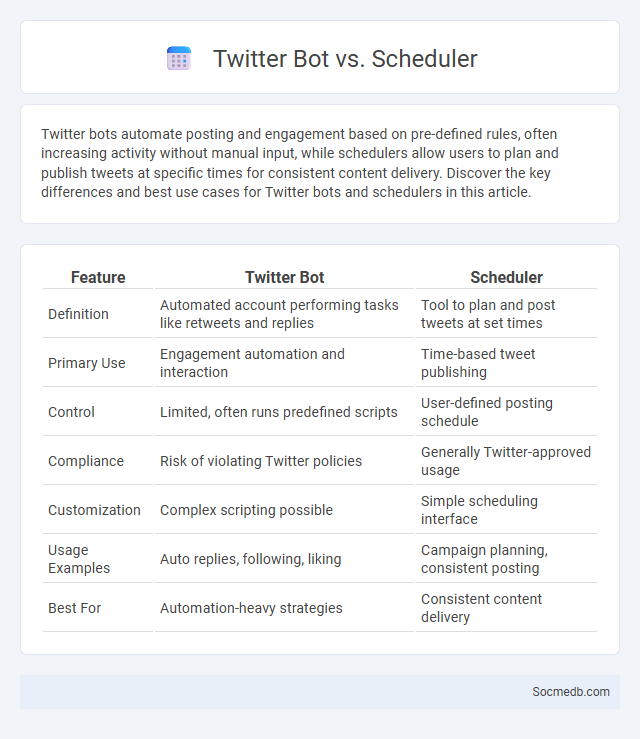
Photo illustration: Twitter Bot vs Scheduler
Twitter bots automate posting and engagement based on pre-defined rules, often increasing activity without manual input, while schedulers allow users to plan and publish tweets at specific times for consistent content delivery. Discover the key differences and best use cases for Twitter bots and schedulers in this article.
Table of Comparison
| Feature | Twitter Bot | Scheduler |
|---|---|---|
| Definition | Automated account performing tasks like retweets and replies | Tool to plan and post tweets at set times |
| Primary Use | Engagement automation and interaction | Time-based tweet publishing |
| Control | Limited, often runs predefined scripts | User-defined posting schedule |
| Compliance | Risk of violating Twitter policies | Generally Twitter-approved usage |
| Customization | Complex scripting possible | Simple scheduling interface |
| Usage Examples | Auto replies, following, liking | Campaign planning, consistent posting |
| Best For | Automation-heavy strategies | Consistent content delivery |
Introduction to Twitter Automation Tools
Twitter automation tools streamline your social media management by scheduling tweets, monitoring mentions, and analyzing engagement metrics efficiently. These platforms enable you to boost your online presence, increase follower interaction, and maintain consistent content delivery without manual effort. Leveraging such tools enhances your ability to grow and engage your audience strategically on Twitter.
What is a Twitter Bot?
A Twitter bot is an automated account programmed to post tweets, retweet, like, or follow users based on specific algorithms or commands. These bots can serve various purposes, including customer service, content dissemination, or amplifying messages, often operating 24/7 without human intervention. By leveraging machine learning and natural language processing, sophisticated Twitter bots can interact contextually with users, enhancing engagement and data collection on the platform.
Understanding Twitter Schedulers
Twitter schedulers enable you to plan and automate your tweets, ensuring consistent engagement without manual posting. These tools optimize your social media strategy by targeting peak activity times and maintaining a steady flow of content. By leveraging Twitter schedulers, your brand can enhance visibility, increase follower interaction, and efficiently manage multiple accounts.
Defining General Bots in Social Media
General bots in social media are automated accounts programmed to perform repetitive tasks such as posting content, liking, commenting, or following users. These bots operate based on preset algorithms and lack human cognition, often influencing user engagement metrics and content visibility. Understanding their behavior is crucial for detecting inauthentic activity and maintaining platform integrity.
Key Differences: Twitter Bot vs Scheduler
Twitter bots automate interactions such as liking, retweeting, and following based on programmed algorithms, often operating without user input to amplify content or manipulate engagement. Schedulers, by contrast, enable users to plan and publish tweets at specific times, offering greater control over content timing and campaign strategy without automating user interactions. Understanding the distinction is critical for managing Twitter presence ethically and effectively, balancing automation with genuine engagement metrics.
Use Cases: When to Use Each Tool
Social media platforms serve distinct use cases: Instagram excels for visual storytelling and brand building through images and short videos, while LinkedIn is ideal for professional networking, B2B marketing, and sharing industry insights. Twitter supports real-time updates, customer engagement, and trending conversations, whereas Facebook offers versatile options for community building, event promotion, and targeted advertising. Choosing the right tool depends on audience demographics, content format, and campaign objectives to maximize engagement and ROI.
Pros and Cons of Twitter Bots
Twitter bots enhance user engagement by automating content sharing, monitoring trending topics, and providing rapid customer service responses. However, they can also spread misinformation, amplify spam, and manipulate public opinion by generating fake interactions or followers. Effective bot management requires balanced strategies to leverage benefits while minimizing risks associated with artificial account activity.
Advantages and Limitations of Schedulers
Schedulers for social media enable You to plan and automate posts across multiple platforms, saving time and maintaining consistent engagement with your audience. They offer detailed analytics and optimal posting times to enhance reach and interaction rates, but may limit spontaneous content sharing and immediate real-time responses. Despite automation, reliance on schedulers can sometimes hinder authentic, timely communication crucial for genuine audience connection.
Compliance and Ethical Considerations
Adhering to compliance standards on social media is essential to avoid legal risks and protect Your brand reputation. Ethical considerations include transparent communication, respecting user privacy, and avoiding misinformation to maintain trust and credibility. Ensuring Your social media strategy aligns with industry regulations and ethical guidelines supports long-term success and stakeholder confidence.
Choosing the Right Automation Tool for Your Needs
Selecting the appropriate social media automation tool depends on your specific goals, such as scheduling posts, analyzing engagement, or managing multiple accounts efficiently. Key factors include user-friendly interfaces, integration with popular platforms like Facebook, Instagram, and Twitter, and features like bulk scheduling, content curation, and real-time analytics. Tools like Hootsuite, Buffer, and Sprout Social offer varied functionalities tailored to businesses of all sizes, enabling optimized workflow and improved audience targeting.
 socmedb.com
socmedb.com